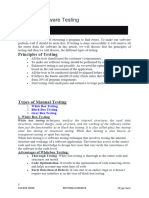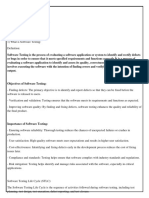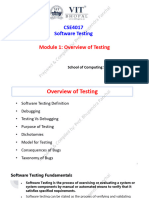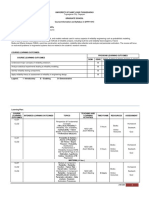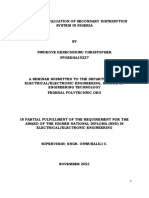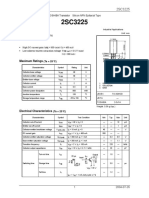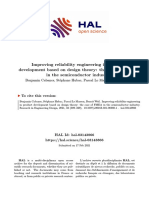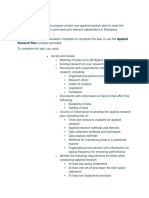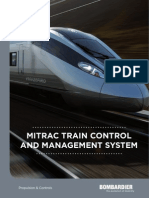0 ratings0% found this document useful (0 votes)
38 views16 pagesSoftware Testing
Uploaded by
luxenta01Copyright
© © All Rights Reserved
We take content rights seriously. If you suspect this is your content, claim it here.
Available Formats
Download as PDF, TXT or read online on Scribd
0 ratings0% found this document useful (0 votes)
38 views16 pagesSoftware Testing
Uploaded by
luxenta01Copyright
© © All Rights Reserved
We take content rights seriously. If you suspect this is your content, claim it here.
Available Formats
Download as PDF, TXT or read online on Scribd
You are on page 1/ 16
Software Testing
Software testing, ensures the quality and reliability of software applications.
Understanding the various types of software testing is essential for developers and
quality assurance professionals alike.
Principles of Software Testing
All the tests should meet the customer’s requirements.
To make our software testing should be performed by a third party.
Exhaustive testing is not possible. As we need the optimal amount of testing based
on the risk assessment of the application.
All the tests to be conducted should be planned before implementing it
It follows the Pareto rule (80/20 rule) which states that 80% of errors come from
20% of program components.
Start testing with small parts and extend it to large parts.
Types of Testing
Types of Software Testing
1. Manual Testing
Manual testing is a technique to test the software that is carried out using the
functions and features of an application. In manual software testing, a tester carries
out tests on the software by following a set of predefined test cases. In this testing,
testers make test cases for the codes, test the software, and give the final report about
that software. Manual testing is time-consuming because it is done by humans, and
there is a chance of human errors.
Advantages of Manual Testing
Fast and accurate visual feedback: It detects almost every bug in the software
application and is used to test the dynamically changing GUI designs like layout,
text, etc.
Less expensive: It is less expensive as it does not require any high-level skill or a
specific type of tool.
No coding is required: No programming knowledge is required while using the
black box testing method. It is easy to learn for the new testers.
Efficient for unplanned changes: Manual testing is suitable in case of unplanned
changes to the application, as it can be adopted easily.
2. Automation Testing
Automated Testing is a technique where the Tester writes scripts on their own and
uses suitable Software or Automation Tool to test the software. It is an Automation
Process of a Manual Process. It allows for executing repetitive tasks without the
intervention of a Manual Tester.
Advantages of Automation Testing:
Simplifies Test Case Execution: Automation testing can be left virtually
unattended and thus it allows monitoring of the results at the end of the process.
Thus, simplifying the overall test execution and increasing the efficiency of the
application.
Improves Reliability of Tests: Automation testing ensures that there is equal
focus on all the areas of the testing, thus ensuring the best quality end product.
Increases amount of test coverage: Using automation testing, more test cases can
be created and executed for the application under test. Thus, resulting in higher test
coverage and the detection of more bugs. This allows for the testing of more
complex applications and more features can be tested.
Minimizing Human Interaction: In automation testing, everything is automated
from test case creation to execution thus there are no changes for human error due
to neglect. This reduces the necessity for fixing glitches in the post-release phase.
Types of Manual Testing
1. White Box Testing
White box testing techniques analyze the internal structures the used data structures,
internal design, code structure, and the working of the software rather than just the
functionality as in black box testing. It is also called glass box testing clear box testing
or structural testing. White Box Testing is also known as transparent testing or open
box testing.
White box testing is a software testing technique that involves testing the internal
structure and workings of a software application. The tester has access to the source
code and uses this knowledge to design test cases that can verify the correctness of the
software at the code level.
Advantages of White box Testing:
Thorough Testing: White box testing is thorough as the entire code and structures
are tested.
Code Optimization: It results in the optimization of code removing errors and
helps in removing extra lines of code.
Early Detection of Defects: It can start at an earlier stage as it doesn’t require any
interface as in the case of black box testing.
Integration with SDLC: White box testing can be easily started in the Software
Development Life Cycle.
Detection of Complex Defects: Testers can identify defects that cannot be
detected through other testing techniques.
2. Black Box Testing
Black-box testing is a type of software testing in which the tester is not concerned with
the internal knowledge or implementation details of the software but rather focuses on
validating the functionality based on the provided specifications or requirements.
Advantages of Black Box Testing:
The tester does not need to have more functional knowledge or programming skills
to implement the Black Box Testing.
It is efficient for implementing the tests in the larger system.
Tests are executed from the user’s or client’s point of view.
Test cases are easily reproducible.
It is used to find the ambiguity and contradictions in the functional specifications.
3. Gray Box Testing
Gray Box Testing is a software testing technique that is a combination of the Black
Box Testing technique and the White Box Testing technique.
1. In the Black Box Testing technique, the tester is unaware of the internal structure
of the item being tested and in White Box Testing the internal structure is known
to the tester.
2. The internal structure is partially known in Gray Box Testing.
3. This includes access to internal data structures and algorithms to design the test
cases.
Advantages of Gray Box Testing:
1. Clarity of goals: Users and developers have clear goals while doing testing.
2. Done from a user perspective: Gray box testing is mostly done from the user
perspective.
3. High programming skills not required: Testers are not required to have high
programming skills for this testing.
4. Non-intrusive: Gray box testing is non-intrusive.
5. Improved product quality: Overall quality of the product is improved.
Types of Black Box Testing
1. Functional Testing
Functional Testing is a type of Software Testing in which the system is tested against
the functional requirements and specifications. Functional testing ensures that the
requirements or specifications are properly satisfied by the application. This type of
testing is particularly concerned with the result of processing. It focuses on the
simulation of actual system usage but does not develop any system structure
assumptions. The article focuses on discussing function testing.
Benefits of Functional Testing
Bug-free product: Functional testing ensures the delivery of a bug-free and high-
quality product.
Customer satisfaction: It ensures that all requirements are met and ensures that
the customer is satisfied.
Testing focused on specifications: Functional testing is focused on specifications
as per customer usage.
Proper working of application: This ensures that the application works as
expected and ensures proper working of all the functionality of the application.
Improves quality of the product: Functional testing ensures the security and
safety of the product and improves the quality of the product.
2. Non-Functional Testing
Non-functional Testing is a type of Software Testing that is performed to verify the
non-functional requirements of the application. It verifies whether the behavior of the
system is as per the requirement or not. It tests all the aspects that are not tested in
functional testing. Non-functional testing is a software testing technique that checks
the non-functional attributes of the system. Non-functional testing is defined as a type
of software testing to check non-functional aspects of a software application. It is
designed to test the readiness of a system as per nonfunctional parameters which are
never addressed by functional testing. Non-functional testing is as important as
functional testing.
Benefits of Non-functional Testing
Improved performance: Non-functional testing checks the performance of the
system and determines the performance bottlenecks that can affect the
performance.
Less time-consuming: Non-functional testing is overall less time-consuming than
the other testing process.
Improves user experience: Non-functional testing like Usability testing checks
how easily usable and user-friendly the software is for the users. Thus, focus on
improving the overall user experience for the application.
More secure product: As non-functional testing specifically includes security
testing that checks the security bottlenecks of the application and how secure is the
application against attacks from internal and external sources.
Types of Functional Testing
1. Unit Testing
Unit testing is a method of testing individual units or components of a software
application. It is typically done by developers and is used to ensure that the individual
units of the software are working as intended. Unit tests are usually automated and are
designed to test specific parts of the code, such as a particular function or method. Unit
testing is done at the lowest level of the software development process, where
individual units of code are tested in isolation.
Advantages of Unit Testing:
Some of the advantages of Unit Testing are listed below.
It helps to identify bugs early in the development process before they become
more difficult and expensive to fix.
It helps to ensure that changes to the code do not introduce new bugs.
It makes the code more modular and easier to understand and maintain.
It helps to improve the overall quality and reliability of the software.
Note: Some popular frameworks and tools that are used for unit testing
include JUnit, NUnit, and xUnit.
It’s important to keep in mind that Unit Testing is only one aspect of software
testing and it should be used in combination with other types of testing such as
integration testing, functional testing, and acceptance testing to ensure that the
software meets the needs of its users.
It focuses on the smallest unit of software design. In this, we test an individual unit
or group of interrelated units. It is often done by the programmer by using sample
input and observing its corresponding outputs.
Example:
1. In a program we are checking if the loop, method, or function is working fine.
2. Misunderstood or incorrect, arithmetic precedence.
3. Incorrect initialization.
2. Integration Testing
Integration testing is a method of testing how different units or components of a
software application interact with each other. It is used to identify and resolve any issues
that may arise when different units of the software are combined. Integration testing is
typically done after unit testing and before functional testing and is used to verify that
the different units of the software work together as intended.
Different Ways of Performing Integration Testing:
Different ways of Integration Testing are discussed below.
Top-down integration testing: It starts with the highest-level modules and
differentiates them from lower-level modules.
Bottom-up integration testing: It starts with the lowest-level modules and
integrates them with higher-level modules.
Big-Bang integration testing: It combines all the modules and integrates them all at
once.
Incremental integration testing: It integrates the modules in small groups, testing
each group as it is added.
Advantages of Integrating Testing
It helps to identify and resolve issues that may arise when different units of the
software are combined.
It helps to ensure that the different units of the software work together as intended.
It helps to improve the overall reliability and stability of the software.
It’s important to keep in mind that Integration testing is essential for complex
systems where different components are integrated.
As with unit testing, integration testing is only one aspect of software testing and it
should be used in combination with other types of testing such as unit testing,
functional testing, and acceptance testing to ensure that the software meets the
needs of its users.
The objective is to take unit-tested components and build a program structure that has
been dictated by design. Integration testing is testing in which a group of components
is combined to produce output.
Integration testing is of four types:
(i) Top-down
(ii) Bottom-up
(iii) Sandwich
(iv) Big-Bang
Example:
1. Black Box testing: It is used for validation. In this, we ignore internal working
mechanisms and focus on “what is the output?”
2. White box testing: It is used for verification. In this, we focus on internal
mechanisms i.e. how the output is achieved.
3. System Testing
System testing is a type of software testing that evaluates the overall functionality and
performance of a complete and fully integrated software solution. It tests if the system
meets the specified requirements and if it is suitable for delivery to the end-users. This
type of testing is performed after the integration testing and before the acceptance
testing.
System Testing is a type of software testing that is performed on a completely
integrated system to evaluate the compliance of the system with the corresponding
requirements. In system testing, integration testing passed components are taken as
input. The goal of integration testing is to detect any irregularity between the units
that are integrated.
Advantages of System Testing:
The testers do not require more knowledge of programming to carry out this
testing.
It will test the entire product or software so that we will easily detect the errors or
defects that cannot be identified during the unit testing and integration testing.
The testing environment is similar to that of the real-time production or business
environment.
It checks the entire functionality of the system with different test scripts and also it
covers the technical and business requirements of clients.
After this testing, the product will almost cover all the possible bugs or errors and
hence the development team will confidently go ahead with acceptance testing.
Types of Integration Testing
1. Incremental Testing
Like development, testing is also a phase of SDLC (Software Development Life
Cycle). Different tests are performed at different stages of the development cycle.
Incremental testing is one of the testing approaches that is commonly used in the
software field during the testing phase of integration testing which is performed
after unit testing. Several stubs and drivers are used to test the modules one after one
which helps in discovering errors and defects in the specific modules.
Advantages of Incremental Testing
Each module has its specific significance. Each one gets a role to play during the
testing as they are incremented individually.
Defects are detected in smaller modules rather than denoting errors and then
editing and re-correcting large files.
It’s more flexible and cost-efficient as per requirements and scopes.
The customer gets the chance to respond to each building.
There are 2 Types of Incremental Testing
1. Top-down Integration Testing
Top-down testing is a type of incremental integration testing approach in which
testing is done by integrating or joining two or more modules by moving down from
top to bottom through the control flow of the architecture structure. In these, high-
level modules are tested first, and then low-level modules are tested. Then, finally,
integration is done to ensure that the system is working properly. Stubs and drivers are
used to carry out this project. This technique is used to increase or stimulate the
behavior of Modules that are not integrated into a lower level.
Advantages Top Down Integration Testing
1. There is no need to write drivers.
2. Interface errors are identified at an early stage and fault localization is also easier.
3. Low-level utilities that are not important are not tested well and high-level testers
are tested well in an appropriate manner.
4. Representation of test cases is easier and simpler once Input-Output functions are
added.
2. Bottom-up Integration Testing
Bottom-up Testing is a type of incremental integration testing approach in which
testing is done by integrating or joining two or more modules by moving upward from
bottom to top through the control flow of the architecture structure. In these, low-level
modules are tested first, and then high-level modules are tested. This type of testing or
approach is also known as inductive reasoning and is used as a synthesis synonym in
many cases. Bottom-up testing is user-friendly testing and results in an increase in
overall software development. This testing results in high success rates with long-
lasting results.
Advantages of Bottom-up Integration Testing
It is easy and simple to create and develop test conditions.
It is also easy to observe test results.
It is not necessary to know about the details of the structural design.
Low-level utilities are also tested well and are also compatible with the object-
oriented structure.
Types of Non-functional Testing
1. Performance Testing
Performance Testing is a type of software testing that ensures software applications
perform properly under their expected workload. It is a testing technique carried out
to determine system performance in terms of sensitivity, reactivity, and stability under
a particular workload.
Performance testing is a type of software testing that focuses on evaluating the
performance and scalability of a system or application. The goal of performance
testing is to identify bottlenecks, measure system performance under various loads
and conditions, and ensure that the system can handle the expected number of users or
transactions.
Advantages of Performance Testing
Performance testing ensures the speed, load capability, accuracy, and other
performances of the system.
It identifies, monitors, and resolves the issues if anything occurs.
It ensures the great optimization of the software and also allows many users to use
it at the same time.
It ensures the client as well as the end-customer’s satisfaction. Performance testing
has several advantages that make it an important aspect of software testing:
Identifying bottlenecks: Performance testing helps identify bottlenecks in the
system such as slow database queries, insufficient memory, or network congestion.
This helps developers optimize the system and ensure that it can handle the
expected number of users or transactions.
2. Usability Testing
You design a product (say a refrigerator) and when it becomes completely ready, you
need a potential customer to test it to check it working. To understand whether the
machine is ready to come on the market, potential customers test the machines.
Likewise, the best example of usability testing is when the software also undergoes
various testing processes which is performed by potential users before launching into
the market. It is a part of the software development lifecycle (SDLC).
Advantages of Usability Testing
Usability testing is preferred to evaluate a product or service by testing it with the proper
users. In Usability testing, the development and design teams will use to identify issues
before coding and the result will be earlier issues will be solved. During a Usability test,
you can,
Learn if participants will be able to complete the specific task completely.
identify how long it will take to complete the specific task.
Gives excellent features and functionalities to the product
Improves user satisfaction and fulfills requirements based on user feedback
The product becomes more efficient and effective
3. Compatibility Testing
Compatibility testing is software testing that comes under the non functional
testing category, and it is performed on an application to check its compatibility
(running capability) on different platforms/environments. This testing is done only
when the application becomes stable. This means simply this compatibility test aims
to check the developed software application functionality on various software,
hardware platforms, networks browser etc. This compatibility testing is very
important in product production and implementation point of view as it is performed
to avoid future issues regarding compatibility.
Advantages of Compatibility Testing
It ensures complete customer satisfaction.
It provides service across multiple platforms.
Identifying bugs during the development process.
There are 4 Types of Performance Testing
1. Load Testing
Load testing determines the behavior of the application when multiple users use it at
the same time. It is the response of the system measured under varying load
conditions.
1. The load testing is carried out for normal and extreme load conditions.
2. Load testing is a type of performance testing that simulates a real-world load on a
system or application to see how it performs under stress.
3. The goal of load testing is to identify bottlenecks and determine the maximum
number of users or transactions the system can handle.
4. It is an important aspect of software testing as it helps ensure that the system can
handle the expected usage levels and identify any potential issues before the
system is deployed to production.
Advantages of Load Testing:
Load testing has several advantages that make it an important aspect of software
testing:
1. Identifying bottlenecks: Load testing helps identify bottlenecks in the system
such as slow database queries, insufficient memory, or network congestion. This
helps developers optimize the system and ensure that it can handle the expected
number of users or transactions.
2. Improved scalability: By identifying the system’s maximum capacity, load
testing helps ensure that the system can handle an increasing number of users or
transactions over time. This is particularly important for web-based systems and
applications that are expected to handle a high volume of traffic.
3. Improved reliability: Load testing helps identify any potential issues that may
occur under heavy load conditions, such as increased error rates or slow response
times. This helps ensure that the system is reliable and stable when it is deployed
to production.
2. Stress Testing
In Stress Testing, we give unfavorable conditions to the system and check how it
perform in those conditions.
Example:
1. Test cases that require maximum memory or other resources are executed.
2. Test cases that may cause thrashing in a virtual operating system.
3. Test cases that may cause excessive disk requirement Performance Testing.
It is designed to test the run-time performance of software within the context of an
integrated system. It is used to test the speed and effectiveness of the program. It is also
called load testing. In it, we check, what is the performance of the system in the given
load.
Example:
Checking several processor cycles.
3. Scalability Testing
Scalability Testing is a type of non-functional testing in which the performance of a
software application, system, network, or process is tested in terms of its capability to
scale up or scale down the number of user request load or other such performance
attributes. It can be carried out at a hardware, software or database level. Scalability
Testing is defined as the ability of a network, system, application, product or a process
to perform the function correctly when changes are made in the size or volume of the
system to meet a growing need. It ensures that a software product can manage the
scheduled increase in user traffic, data volume, transaction counts frequency, and
many other things. It tests the system, processes, or database’s ability to meet a
growing need.
Advantages of Scalability Testing
It provides more accessibility to the product.
It detects issues with web page loading and other performance issues.
It finds and fixes the issues earlier in the product which saves a lot of time.
It ensures the end-user experience under the specific load. It provides customer
satisfaction.
It helps in effective tool utilization tracking.
4. Stability Testing
Stability Testing is a type of Software Testing to checks the quality and behavior of
the software under different environmental parameters. It is defined as the ability of
the product to continue to function over time without failure.
It is a Non-functional Testing technique that focuses on stressing the software
component to the maximum. Stability testing is done to check the efficiency of a
developed product beyond normal operational capacity which is known as break
point. It has higher significance in error handling, software reliability, robustness, and
scalability of a product under heavy load rather than checking the system behavior
under normal circumstances.
Stability testing assesses stability problems. This testing is mainly intended to check
whether the application will crash at any point in time or not.
Advantages of Stability Testing
1. It gives the limit of the data that a system can handle practically.
2. It provides confidence on the performance of the system.
3. It determines the stability and robustness of the system under load.
4. Stability testing leads to a better end-user experience.
Other Types of Testing
1. Smoke Testing
Smoke Testing is done to make sure that the software under testing is ready or stable
for further testing
It is called a smoke test as the testing of an initial pass is done to check if it did not catch
fire or smoke in the initial switch-on.
Example:
If the project has 2 modules so before going to the module make sure
that module 1 works properly.
Advantages of Smoke Testing
1. Smoke testing is easy to perform.
2. It helps in identifying defects in the early stages.
3. It improves the quality of the system.
4. Smoke testing reduces the risk of failure.
5. Smoke testing makes progress easier to access.
2. Sanity Testing
It is a subset of regression testing. Sanity testing is performed to ensure that the code
changes that are made are working properly. Sanity testing is a stoppage to check
whether testing for the build can proceed or not. The focus of the team during the
sanity testing process is to validate the functionality of the application and not detailed
testing. Sanity testing is generally performed on a build where the production
deployment is required immediately like a critical bug fix.
Advantages of Sanity Testing
Sanity testing helps to quickly identify defects in the core functionality.
It can be carried out in less time as no documentation is required for sanity testing.
If the defects are found during sanity testing, the project is rejected which is
helpful in saving time for execution of regression tests.
This testing technique is not so expensive when compared to another type of
testing.
It helps to identify the dependent missing objects.
3. Regression Testing
The process of testing the modified parts of the code and the parts that might get
affected due to the modifications ensures that no new errors have been introduced in
the software after the modifications have been made. Regression means the return of
something and in the software field, it refers to the return of a bug.
Advantages of Regression Testing
It ensures that no new bugs have been introduced after adding new functionalities
to the system.
As most of the test cases used in Regression Testing are selected from the existing
test suite, and we already know their expected outputs. Hence, it can be easily
automated by the automated tools.
It helps to maintain the quality of the source code.
4. Acceptance Testing
Acceptance testing is done by the customers to check whether the delivered products
perform the desired tasks or not, as stated in the requirements. We use Object-
Oriented Testing for discussing test plans and for executing the projects.
Advantages of Acceptance Testing
1. This testing helps the project team to know the further requirements of the users
directly as it involves the users for testing.
2. Automated test execution.
3. It brings confidence and satisfaction to the clients as they are directly involved in
the testing process.
4. It is easier for the user to describe their requirement.
5. It covers only the Black-Box testing process and hence the entire functionality of
the product will be tested.
5. User Acceptance Testing
User Acceptance Testing is a testing methodology where clients/end users participate
in product testing to validate the product against their requirements. It is done at the
client’s site or the developer’s site. For industries such as medicine or aerospace,
contractual and regulatory compliance testing, and operational acceptance tests are
also performed as part of user acceptance tests. UAT is context-dependent and UAT
plans are prepared based on requirements and are not required to perform all kinds of
user acceptance tests and are even coordinated and contributed by the testing team.
6. Exploratory Testing
Exploratory Testing is a type of software testing in which the tester is free to select
any possible methodology to test the software. It is an unscripted approach to software
testing. In exploratory testing, software developers use their learning, knowledge,
skills, and abilities to test the software developed by themselves. Exploratory testing
checks the functionality and operations of the software as well as identifies the
functional and technical faults in it. Exploratory testing aims to optimize and improve
the software in every possible way.
Advantages of Exploratory Testing
Less preparation required: It takes no preparation as it is an unscripted testing
technique.
Finds critical defects: Exploratory testing involves an investigation process that
helps to find critical defects very quickly.
Improves productivity: In exploratory testing, testers use their knowledge, skills,
and experience to test the software. It helps to expand the imagination of the
testers by executing more test cases, thus enhancing the overall quality of the
software.
7. Adhoc Testing
Adhoc testing is a type of software testing that is performed informally and randomly
after the formal testing is completed to find any loophole in the system. For this
reason, it is also known as Random or Monkey testing. Adhoc testing is not performed
in a structured way so it is not based on any methodological approach. That’s why
Adhoc testing is a type of Unstructured Software Testing.
Advantages of Adhoc testing
The errors that can not be identified with written test cases can be identified by
Adhoc testing.
It can be performed within a very limited time.
Helps to create unique test cases.
This test helps to build a strong product that is less prone to future problems.
This testing can be performed at any time during Softthe ware Development Life
Cycle Process (SDLC)
8. Security Testing
Security Testing is a type of Software Testing that uncovers vulnerabilities in the
system and determines that the data and resources of the system are protected from
possible intruders. It ensures that the software system and application are free from
any threats or risks that can cause a loss. Security testing of any system is focused on
finding all possible loopholes and weaknesses of the system that might result in the
loss of information or repute of the organization.
Advantages of Security Testing
1. Identifying vulnerabilities: Security testing helps identify vulnerabilities in the
system that could be exploited by attackers, such as weak passwords, unpatched
software, and misconfigured systems.
2. Improving system security: Security testing helps improve the overall security of
the system by identifying and fixing vulnerabilities and potential threats.
3. Ensuring compliance: Security testing helps ensure that the system meets relevant
security standards and regulations, such as HIPAA, PCI DSS, and SOC2.
9. Globalization Testing
Globalization Testing is a type of software testing that is performed to ensure the
system or software application can function independently of the geographical and
cultural environment. It ensures that the application can be used all over the world and
accepts all language texts. Nowadays with the increase in various technologies, every
software product is designed in such a way that it is a globalized software product.
Benefits of Globalization Testing
Helps to create scalable products: It makes the software product more flexible
and scalable.
Save time: It saves overall time and effort for software testing.
Reduce time for localization testing: Globalization testing helps to reduce the
time and cost of localization testing.
10. Regression Testing
Regression testing is a method of testing that is used to ensure that changes made to the
software do not introduce new bugs or cause existing functionality to break. It is
typically done after changes have been made to the code, such as bug fixes or new
features, and is used to verify that the software still works as intended.
Regression testing can be performed in different ways, such as:
Retesting: This involves testing the entire application or specific functionality that
was affected by the changes.
Re–execution: This involves running a previously executed test suite to ensure
that the changes did not break any existing functionality.
Comparison: This involves comparing the current version of the software with a
previous version to ensure that the changes did not break any existing
functionality.
Advantages of Regression Testing
It helps to ensure that changes made to the software do not introduce new bugs or
cause existing functionality to break.
It helps to ensure that the software continues to work as intended after changes
have been made.
It helps to improve the overall reliability and stability of the software.
It’s important to keep in mind that regression testing is an ongoing process that
should be done throughout the software development lifecycle to ensure that the
software continues to work as intended. It should be automated as much as
possible to save time and resources. Additionally, it’s important to have a well-
defined regression test suite that covers
Every time a new module is added leads to changes in the program. This type of testing
makes sure that the whole component works properly even after adding components to
the complete program.
Example:
In school records, suppose we have module staff, students, and finance combining
these modules and checking if the integration of these modules works fine in
regression testing.
11. Smoke Testing
Smoke Testing is done to make sure that the software under testing is ready or stable
for further testing
It is called a smoke test as the testing of an initial pass is done to check if it did not catch
fire or smoke in the initial switch-on.
Example:
If the project has 2 modules so before going to the module make sure that module 1
works properly.
12. Alpha Testing
Alpha testing is a type of validation testing. It is a type of acceptance testing that is done
before the product is released to customers. It is typically done by QA people.
Example:
When software testing is performed internally within the organisation.
13. Beta Testing
The beta test is conducted at one or more customer sites by the end-user of the software.
This version is released for a limited number of users for testing in a real-time
environment.
Example:
When software testing is performed for the limited number of people.
14. Object-Oriented Testing
Object-Oriented Testing testing is a combination of various testing techniques that help
to verify and validate object-oriented software. This testing is done in the following
manner:
Testing of Requirements,
Design and Analysis of Testing,
Testing of Code,
Integration testing,
System testing,
User Testing.
Advantages of Software Testing
1. Improved software quality and reliability.
2. Early identification and fixing of defects.
3. Improved customer satisfaction.
4. Increased stakeholder confidence.
5. Reduced maintenance costs.
6. Low Failure
7. Bug-Free Application.
8. Security
9. Speed Up the Development Process
Disadvantages of Software Testing
Time-Consuming and adds to the project cost.
This can slow down the development process.
Not all defects can be found.
Can be difficult to fully test complex systems.
Potential for human error during the testing process.
You might also like
- E-Notes 32820 Content Document 20250313054541PMNo ratings yetE-Notes 32820 Content Document 20250313054541PM85 pages
- Comprehensive Guide to Software TestingNo ratings yetComprehensive Guide to Software Testing66 pages
- Analysis of The Combined Effects of Load Cycling Thermal Transients and Electrothermal Stress On Life Expectancy of High-Voltage AC CablesNo ratings yetAnalysis of The Combined Effects of Load Cycling Thermal Transients and Electrothermal Stress On Life Expectancy of High-Voltage AC Cables10 pages
- Aircraft Inspection Techniques Initial - 2 Days: Date Category Venue Level PriceNo ratings yetAircraft Inspection Techniques Initial - 2 Days: Date Category Venue Level Price4 pages
- ProjectResearchReport - Digital TwininIndustry4.0No ratings yetProjectResearchReport - Digital TwininIndustry4.032 pages
- Teaching Distribution System Reliability Evaluation Using Monte Carlo SimulationNo ratings yetTeaching Distribution System Reliability Evaluation Using Monte Carlo Simulation7 pages
- Energy Efficiency in Hospitals and Laboratories: KeywordsNo ratings yetEnergy Efficiency in Hospitals and Laboratories: Keywords8 pages
- Reliability Evaluation of Secondary Distribution System in NigeriaNo ratings yetReliability Evaluation of Secondary Distribution System in Nigeria12 pages
- MHDP-18-R-02 RAM For Upgrade Condensate Stabilization and Sour Water Treatment at UGP 2.0No ratings yetMHDP-18-R-02 RAM For Upgrade Condensate Stabilization and Sour Water Treatment at UGP 2.051 pages
- Improving Reliability Engineering in Product Development Based On Design TheoryNo ratings yetImproving Reliability Engineering in Product Development Based On Design Theory46 pages
- Probabilistic Methods in Geotechnical Engineering: Proceedings of The Conference, Canberra, 10-12 February 1993 First Edition Li100% (3)Probabilistic Methods in Geotechnical Engineering: Proceedings of The Conference, Canberra, 10-12 February 1993 First Edition Li55 pages
- 1 - Introduction To Software Project ManagementNo ratings yet1 - Introduction To Software Project Management20 pages
- Building Condition Assessments Metrics Best Practices0% (1)Building Condition Assessments Metrics Best Practices5 pages
- Electrical Wire Rope Hoists: Standard Product CatalogueNo ratings yetElectrical Wire Rope Hoists: Standard Product Catalogue24 pages
- Structural Reliability Analysis and Design100% (4)Structural Reliability Analysis and Design455 pages
- BT MITRAC Train Control and Management System Bro enNo ratings yetBT MITRAC Train Control and Management System Bro en5 pages





